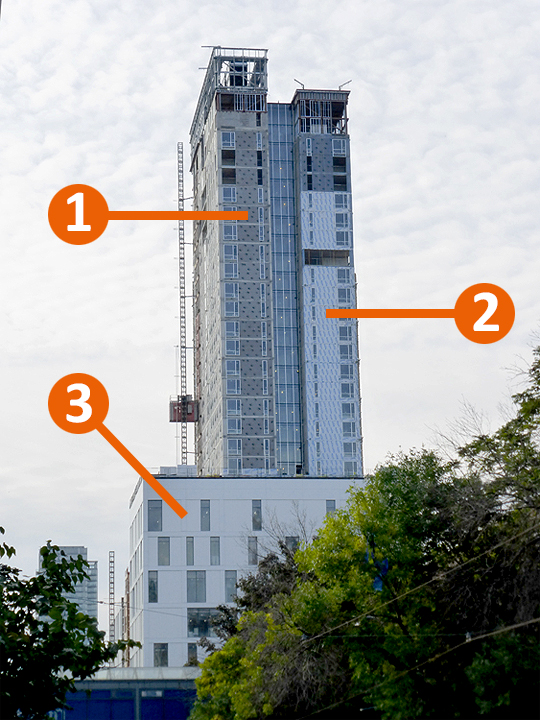DCC construction to focus on exterior shell now that structure is complete
With the completion of the mechanical rooms’ steel framing, the superstructure of the Daphne Cockwell Health Sciences Complex (DCC) is complete and work is well underway on the building envelope—the layers that make up the outer shell of the building.

Several of the different exterior layers are currently being applied to the outside of the DCC’s framed structure, including:
- Sheathing: The residence tower has its windows and “sheathing” almost completed. The sheathing is a layer of wallboard that covers the building’s outer frame. This type of wallboard is usually a composite of materials that have greater wind and moisture resistance than the drywall used for the walls in a building’s interior.
- Vapour barrier: The sheathing is then covered with a vapour barrier that prevents wind and moisture from penetrating the building. This membrane will be covered with a mineral fibre insulation made from basalt rock and slag, so the building will be well protected from the extreme temperature fluctuations of Ontario summers and winters.
- Cladding: The main building complex is now fully covered with its final layer of “cladding” (the finished facing) mounted on metal brackets. It is this layer of white aluminum that will also cover the tower and give the building its final appearance and character. A similar cladding system provides the accent colour up the south side of the building.
In addition to the exterior wall layers, the building envelope includes includes all exterior doors, window systems, roofing, metal flashing, acoustic and thermal insulation, which as a system also prevent energy loss and extreme heat gains.
The DCC building envelope draws on various building-science standards and engineering practices to outperform durability limitations and ensure that it will resist UV deterioration, manage air flow and moisture—both in the air and within the wall cavity—and will help maintain controlled interior temperatures for a high-comfort environment to support learning and living.
The Daphne Cockwell Health Sciences Complex is expected be fully covered in its cladding building envelop finish for the new year.